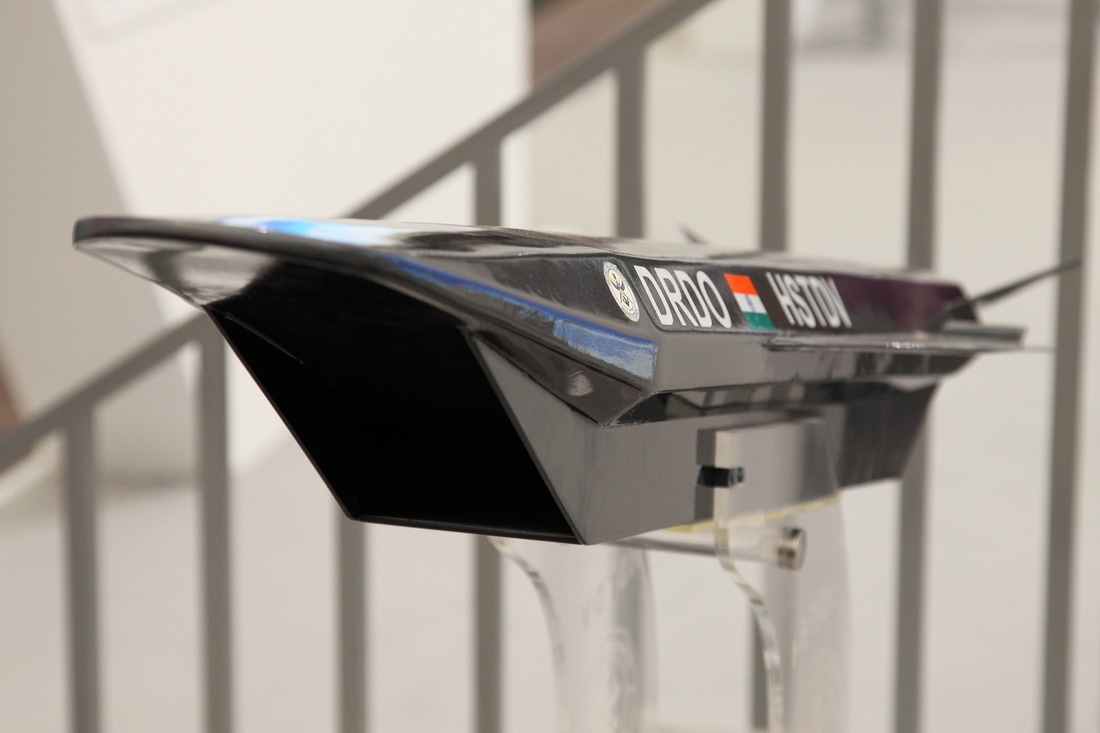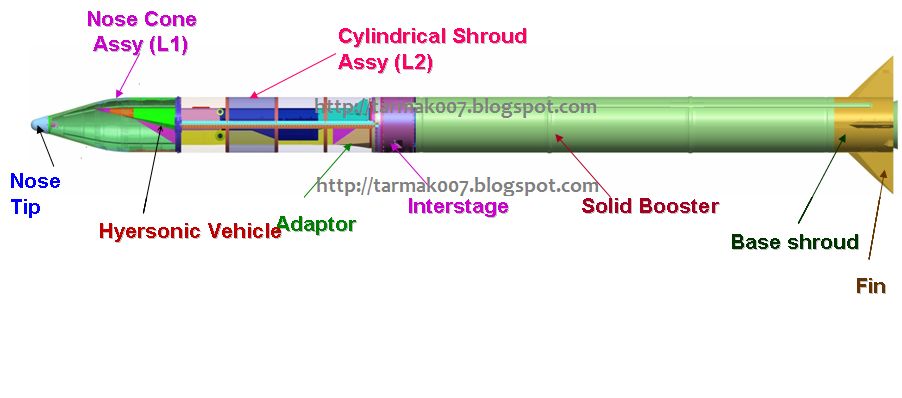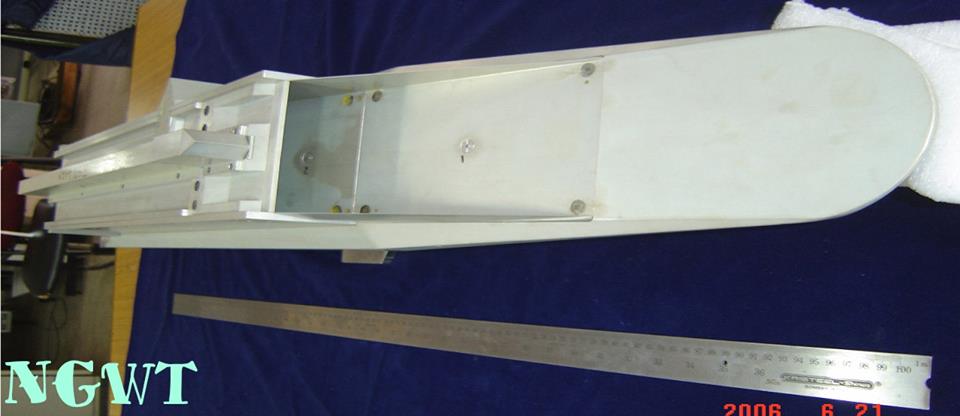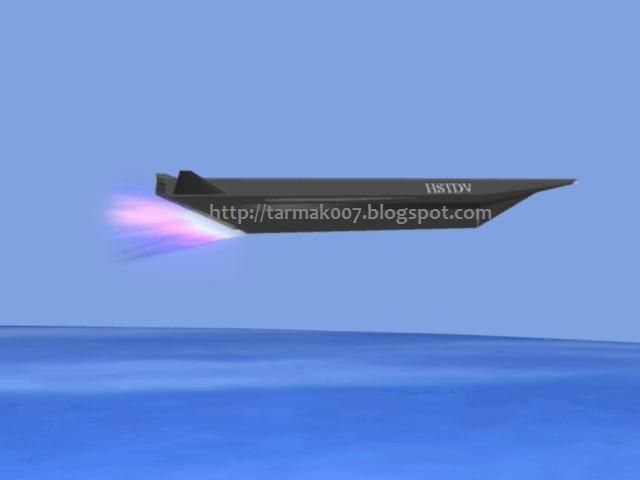|
The HSTDV is an unmanned scramjet demonstration aircraft for hypersonic speed flight. The HSTDV program is run by DRDO.HSTDV is awaiting a crucial test . A 20-22 second test of the HSTDV would be crucial for the hypersonic missile program. The design for airframe attachment with the engine was completed in the year 2004. We have eclusive images of that testframe. Initial ground tests with the kerosene-fuelled scramjet have been completed at the Terminal Ballistics Research Laboratory of DRDO situated in Chandigarh and the propulsion system is now being integrated with the air vehicle. Roughly 10 engine runs have been completed although the development team has yet to undertake a sustained 20-second burn, which is the operating time required for initial flight trials. As of December 2011, the scientists had proved technologies for aerodynamics, aero-thermodynamics, engine and hot structures through design and ground testing. HSTDV will be powered by a scramjet engine using hydrocarbon fuel injected through a set of staggered struts. The first aerodynamic wind-tunnel test was held in Israel (2007) and later in Russia (2009)) as India doesn't have a hypersonic facility to test larger cross-section of platforms at that time. Later In November 2010, DRDO officials told press that they were in the process of opening four state-of-the-art facilities inside as well as in the vicinity of Hyderabad at a cost of more than ₹10 billion over the next five years. Reportedly, they will invest ₹3 to 4 billion for setting up a much-needed hypersonic wind tunnel at Hyderabad’s Missile Complex. The facility facilitates testing of various parameters of the HSTDV, including engine performance. It is pivotal to test the HSTDV in the range of up to Mach 12. This is a unique installation in India. India is the second country to have planned an autonomous flight of the hypersonic air-breathing vehicle; the first being the USA which demonstrated the flight through X-43 and X-51 programs. France is also planning the autonomous flight sometime through LEA program. These technologies can also be use in India’s reusable launch vehicles. The eventual target is launching the hypersonic air-breathing vehicle called Cruise Vehicle (CV) to a Mach number of 6.5 at an altitude of 30-35 km using a rocket launch vehicle The Test The scramjet-integrated vehicle is mounted on top of an already proven Agni missile booster motor and protected by aerodynamic fairings. The solid booster injects the hypersonic vehicle at the desired altitude of 32 km and Mach number of 6.5. The aerodynamic fairings are separated and the hypersonic vehicle is also separated from the booster. After separation, the scramjet engine is ignited and the vehicle cruises for a short duration of 20 seconds. High temperature materials are used for the engine and airframe construction. Combustion inside the engine occurs at 1.2 km/sec. The HSTDV program aims to produce a hydrocarbon-fuelled scramjet capable of Mach 6-7 and autonomously guided flight. The HSTDV will pave the way for a hypersonic cruise missile and platforms that can perhaps be applied to other tasks, such as very high-speed reconnaissance. The 1-metric-ton, 5.6-meter (18-ft.)-long air vehicle features a flattened octagonal cross section with mid-body stub-wings and raked tail fins and a 3.7-meter rectangular section air intake. The scramjet engine is located under the mid-body, with the aftbody serving as part of the exhaust nozzle. Development work on the engine is also in progress. Two parallel fences in the forebody are meant to reduce spillage and increase thrust. Part span flaps are provided at the trailing edge of the wings for roll control. A deflectable nozzle cowl at the combustor end can deflect up to 25 deg. to ensure satisfactory performance during power-off and power-on phases. Surfaces of the airframe’s bottom, wings and tail are made of titanium alloy, while aluminum alloy comprises the top surface. The inner surface of the double-wall engine is niobium alloy and the outer surface is nimonic alloy. The materials were developed indigenously give India a great advantage for the future R&D. A hypersonic missile with a scramjet engine at Mach 20 plus is so indefensible .And it has tremendous range extension utility. For instance an Agni-5 with a hypersonic last stage will extend its range well beyond intercontinental distances. HSTDV is much more advanced than the Chinese hypersonic Glide vehicle which uses a technique called boost glide to maneuver and evade missile defense systems. More precisely HGV is a maneuvering warhead rather than free falling warhead. The boost-glide concept relies on the lift generated during the hypersonic flight of reentry. HGV stays within the stratosphere after reentry and pull-up, and glides through the air. Although that creates more drag, warheads fly further than they would on a higher trajectory through space, and are too low to be intercepted by exo-atmospheric kill vehicles. But the same time warheads have less speed and altitude as they near the target, making them vulnerable to lower-tier interceptors. Meanwhile HSTDV can be used to power each warhead dropped from Agni missile and it can sustain the hypersonic speed & maneuverability until the impact, makes it more deadly than Chinese glide vehicle. And also it can improve the range of missiles by 1000 to 2000 or even more. A combination of boost glide and Scramjet is also possible. References
Wikipedia Tarmak007.logspot.com Some Other Sources
D P SENGAR
11/2/2017 08:55:09 pm
This type information is very interested
Reply
Gagandeep Singh
4/14/2018 10:27:50 pm
It is really a very good platform. Knowhow given is deep not available elsewhere. I just couldn't help marvel at the language employed in article on Rafale and Eurofighter Typhoon. I pan to visit it more often.
Reply
Leave a Reply. |
AuthorPalash Choudhari Archives
June 2021
Categories
All
|





 RSS Feed
RSS Feed
